Palm plants add classic beauty to your home, and they’re easier to care for than most people think. They can thrive for decades as houseplants when you understand their needs.
Plus they’re fun to collect, and there are lots of benefits of growing them indoors. This detailed guide is designed to teach you all you need to know about how to care for palm plants indoors.
From water, light, fertilizer, and soil, to pruning, troubleshooting common problems, and pest control – everything you need is right here.
Benefits Of Growing Palm Plants Indoors
Growing palm plants and trees indoors is very popular these days, and they make excellent houseplants. There are lots of benefits of having them in your home too:
- Palm plants add a lovely tropical feel indoors
- They are tolerant of neglect, and will easily adapt to growing indoors
- Most of them don’t require a lot of light
- Some can help to clean the air in your home
- They can live for many years with the proper care

Different Types Of Indoor Palm Plants
There are lots of different types of palm plants that can thrive indoors. Here are a few of the most common varieties:
Indoor Palm Plant Care & Growing Instructions
Even though there are tons of different varieties of indoor palm plants, they all require the same basic care to grow their best. Follow my tips below to help create the perfect environment for them.
Watering
Palm plants can tolerate being under watered, but they will grow their best with consistent moisture. Be very careful not to over water though, because this is their number #1 killer.
Only let the soil dry out slightly between waterings in the summer, to about 1″ deep. During the winter, you can let them dry out a bit more, or 1-2″ deep.
When it’s time, give your plant a deep drink and allow the excess to drain completely from the holes in the bottom of the pot. If you struggle with watering, I recommend buying an inexpensive moisture gauge to help you get it just right.
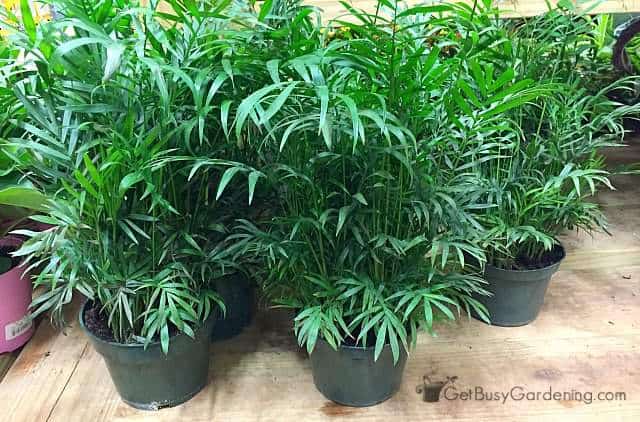
Light
Palm plants can easily adapt to low light conditions indoors. Most of them need bright, indirect light, and their leaves can burn in the direct sun.
They won’t survive in complete darkness though, so if there’s no sunlight in the room, you’ll definitely need to add a grow light.
If you put your palm plant outside during the summer, make sure to keep it in the shade so it doesn’t get sunburn.
Potting Soil
When it comes to the type of soil to use, palm plants aren’t super picky. But the best potting medium for them is a loose, porous mix, such as a combo of peat moss, leaf mold, and shredded bark.
You can also buy a fast draining mix that’s specifically made for them. Otherwise they will do just fine in a general purpose one.
If you tend to forget to water your plants, then you can add some peat moss and/or vermiculite into the soil to help it retain moisture longer.

Fertilizer
While they don’t really need to be fertilized, indoor palm plants will benefit from being fed as a part of your regular care routine.
However, they are very sensitive to chemical fertilizers, which can cause brown tips and margins, or easily burn the roots. So it’s best to use an organic option. My favorites are Jobe’s, Espoma, and Dr. Earth.
Whatever type you decide to use, be sure to only feed your plants during the spring and summer, and stop during the fall and winter to give them a rest.

Pest Control Tips
Spider mites are the most common pest that attack indoor palm plants. Keep the humidity level high around the foliage to fend them off. Houseplant scale and mealy bugs can also become a problem sometimes.
If you find any bugs, begin treating them immediately to prevent them from spreading. I recommend using organic neem oil, which is a natural pesticide.
Insecticidal soap also works well, or you can make your own by mixing 1 teaspoon of mild liquid soap with 1 liter of water.
Related Post: How To Get Rid Of Houseplant Bugs
Pruning
You can regularly trim back your indoor palm plants to keep them looking nice, or to maintain their size and shape. Spring is the best time to do maintenance pruning or to remove long, leggy stems.
It’s common for the lower leaves to turn yellow or brown with age, and you can cut off those fronds anytime of the year using regular pruning shears.
Brown tips and leaf edges are also very common. To trim those off, use a sharp pair of bonsai shears or micro-tip snips.
Troubleshooting Common Problems
It’s usually pretty easy to care for palm plants indoors. But sometimes your plant will start to have problems, and you’re not sure why. Below are the most common issues you might run into, with my tips for how to fix them:
Leaves Turning Brown Or Yellow
It’s normal for the lower, oldest fronds to turn yellow, then brown, and eventually die. So you can just prune those off as part of your regular maintenance routine.
However, if the newer, top leaves are turning brown and dying, then it’s usually caused by improper watering (too much or too little), bugs, or lack of humidity.
Let the soil dry 1-2″ deep before watering again, and check your plant for any signs of bugs. If it’s very dry in your home, try running a humidifier in the room or mist the foliage.
Brown Tips & Margins
One of the most common problems that indoor palm plants have is brown leaf margins and tips. This is usually caused by lack of water, dry air, chemical fertilizers, or pests.
Check to make sure you’re watering enough, and inspect the leaves for bugs. Use organic fertilizer rather than chemicals, and try to increase the humidity level around the plant.
For some species, brown tips and margins are just a normal part of their life cycle, so it’s not always something you can fix. If they bother you, simply trim them off to keep your plant looking its best.
Indoor Palm Tree Is Dying
There are several things that can cause indoor palm plants to die. The most common one is overwatering, but it could also be a lack of humidity, or inadequate lighting.
The soil should dry slightly between waterings, and never be completely bone dry or soggy.
Ensure your plant gets bright, indirect sunlight, and increase the humidity level if it has brown tips.
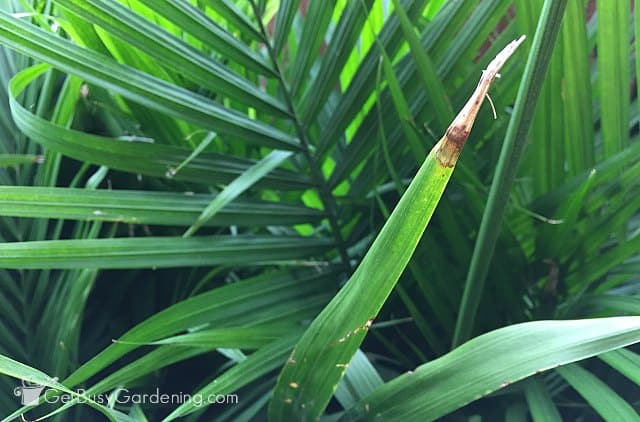
Indoor palm trees and plants are very low maintenance, and will thrive for years when you give them the proper care. Follow the tips in this guide for the best success.
If you want to learn all there is to know about maintaining healthy indoor plants, then you need my Houseplant Care eBook. It will show you everything you need to know about how to keep every plant in your home thriving. Download your copy now!
Share your indoor palm plant care tips and advice in the comments below.


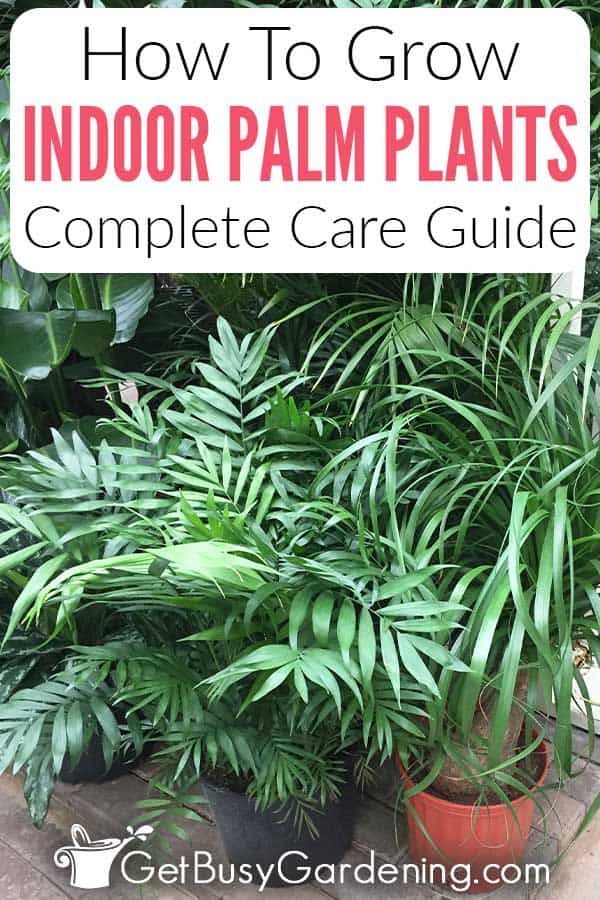
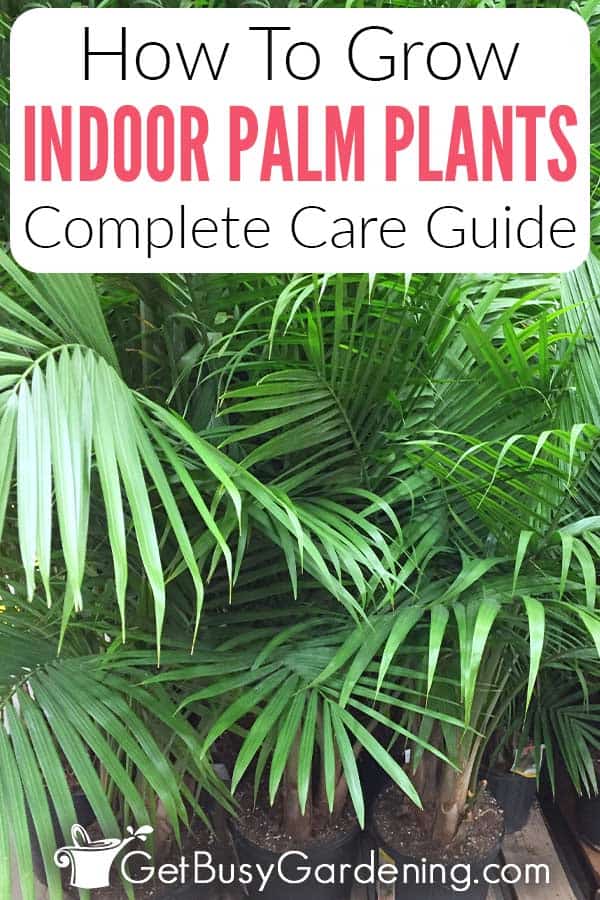
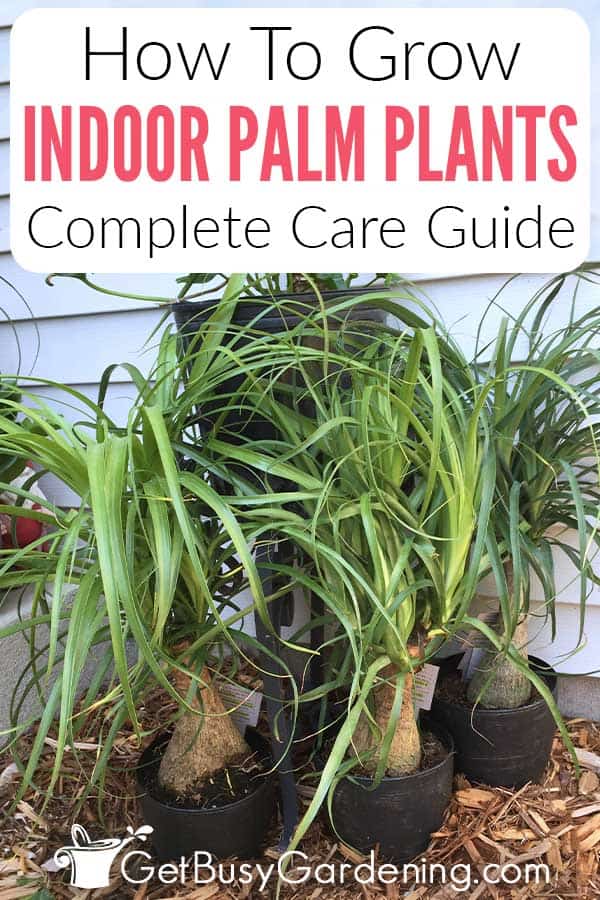
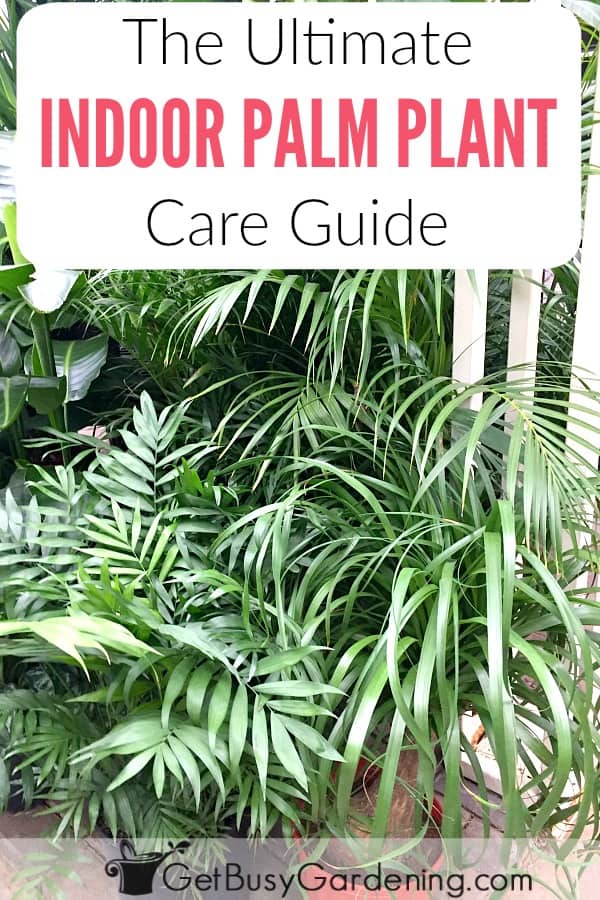
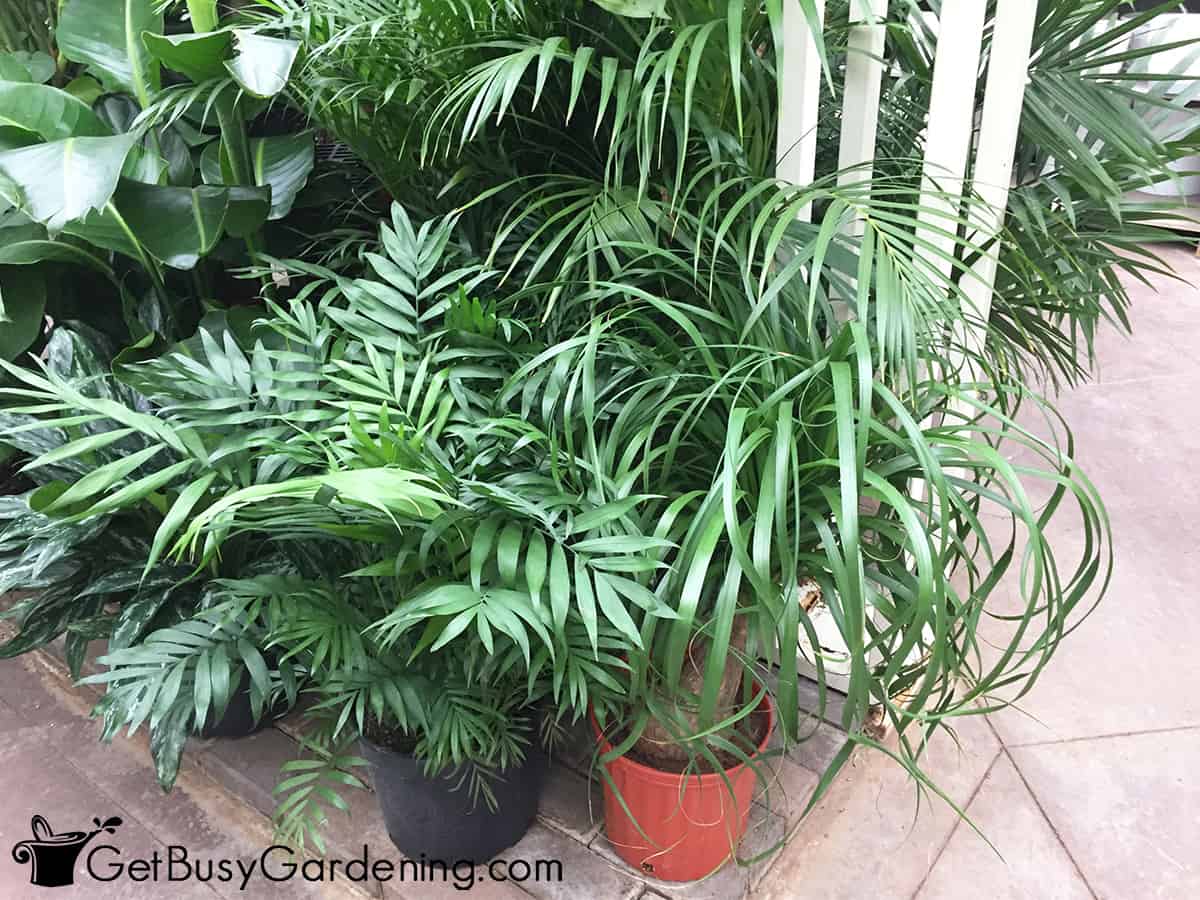



Rose says
I brought a tiny palm from Florida to northern Minnesota. Have had it for 13 years. What should I do when it flowers. I’ve been cutting them off. Don’t know if that’s the best thing to do.
Amy Andrychowicz says
Wow, that’s wonderful! Sounds like whatever you’re doing has been great for your palm plant! I’m not sure what type of palm you have, or if you should cut the flowers off or not. Though, if it was going to die after flowering, cutting the flowers off wouldn’t save it. So my gut is telling me that it should be ok to let it flower. But, it would be better to know what type of palm plant you have to be sure. Did someone tell you that you needed to cut the flowers off, or are you just worried the flowers will harm the plant?
Donna says
Hi,
My palm did so well on the patio over the summer. I have had nothing but problems with it since I brought it inside and it was so beautiful! I waited to bring it in until the temperature was about 58 degrees in the evenings. There was still warm sunshine during the day, so I did not worry.
I know palms can go into shock after moving them but this is ridiculous. I do not see any spider mites or other signs of insects.
The beautiful, healthy fronds started turning yellow and then quickly turned brown. I tried watering more, watering less, to no avail. I have removed entire brown stems, hoping to stop it from dying. Yet every day, there are more brownish, yellowish leaves. Even new growth suddenly turned brown on the ends. The plant is less than half the lush thickness it was when I brought it in. It was about two feet when I bought it. It grew to more than four feet just in the three months I had it before it suddenly started dying. I never fertilized it because I wanted it to adjust well after I brought it home, so fertilizer burn is not the issue. Now, I did not fertilize it because it is dying rapidly. I just cannot seem to stop whatever is wrong.
There is not much light in my apartment and sitting it by the patio door is too cold for Ohio winters (I even get chilled sitting close to the patio now that it is cold). So I have it next to two other tropical plants, where it gets ample light from a large ceiling light. The other two tropical plants (different variety) are doing quite well.
I do let the soil dry out between waterings. Nothing works. Any ideas what in the world happened?
Thank you!
Amy Andrychowicz says
Oh no, so sorry to hear that your palm plant is not doing very well! It sounds to me like it could be a watering problem. Most houseplants go into a state of dormancy during the winter. The cooler fall temperatures followed by being moved indoors were triggers to your palm to start slowing down it’s growth. They don’t go completely dormant, and can still put on new growth during the winter, but it’s much, much slower. So, because of that, plants don’t need as much water in the fall and winter months as they do in the spring and summer. My guess is that it may have gotten too much water at some point this fall. Stick your finger one inch into the soil and check how wet it is. Wait until it’s dry before you water your plant again. Not completely bone dry, but not wet (if that make sense). Allow the soil to dry out more between watering in the winter than you do in the summer. An inexpensive soil moisture gauge is a good tool to help with consistent watering.
I would also leave it in the spot where you have it, and don’t move it again until you’re ready to put it back outside in the spring. Some plants are very sensitive to being moved, and that could be a big part of the issue too. Good luck, I hope it will recover for you!
Barb says
Hi Amy, Thanks so much for this article and sharing your expertise. I have a palm which has been growing well indoors for a few years (maybe longer???) I’ve never transplanted it and I think it really could use it – one frond grew very small and the next is shooting up very tall but hasn’t opened yet. It’s now getting cold here – I’m in MI. Is it ok to transplant it now (and fertilize) or should I wait until spring? Thank you.
Amy Andrychowicz says
The best time to repot houseplants is in the spring. Repotting triggers new growth, and you don’t want to do that in the fall. Definitely don’t fertilize your palm plant in the fall or winter. Houseplants go into a state of dormancy during the winter, and fertilizing them in the fall can cause weak new growth, or put stress on the plant. If I were you, I would wait until March to repot your palm. Good luck!
Barb says
Thanks so much, Amy!
Amy Andrychowicz says
You’re welcome!
Joanie says
I have what I believe is a majesty palm and a large stalk of it got broken off…wondering if I put it in water or replant it if it will regrow? Or if I should just throw it out?
Thank you
Amy Andrychowicz says
Unfortunately the broken palm branch won’t regrow in water.
Bill Hopkins says
Hello Amy,
I have had three parlor palm plants over the years. The first two died after about ten years, the most recent plant died after a few months. Mortality was the same for each plant, whole branches of the plant progressively dried out until the plant eventually died. In each case I don’t believe I over/under watered, over fertilized, provided too much/little light, etc. Also mites were not in evidence. Each plant was put in the same soil. Last but not least, the plant that died after a few months was small when I purchased it. I was told put it in a small pot as the root structure prefers some confinement. Thoughts?
Amy Andrychowicz says
It’s hard to know for sure, but were the older palm plants moved at any point prior to them starting to die? If so, it could have been something with the new environment (like too cold or too hot) that they didn’t like. As for the new palm plant, it’s never a good idea to repot a new plant right after bringing it home. Plants go into shock when they’re moved, and you never know what a plant goes through from the time it leaves the greenhouse to the time you buy it. It’s always best to find a spot for your new plant, and just leave it alone for a few months to let it adjust to it’s new environment. My guess is that it was either poorly cared for before you bought it, and/or it died because the shock of being moved and then transplanted was too much for it. Sorry for your losses.
Shannon says
I have a 20+yr old Palm tree that suddenly started to die. I’m guessing it’s due to the new kitten enjoying the large pot and nice soil to poop and pee in. She’s so much fun!! LoL. I’m thinking of repotting the Palm but don’t want to stress it out anymore then it already is. Do you have any ideas? This Palm is special to me and I would be devastated to let it go without a good fight! Thank you
Amy Andrychowicz says
I feel your pain about the kitten, I’ve had a few of those myself. 🙂 I put tin foil over the top of the pots to keep my kittens out, and train them not to use it as a litter box. A shot from the spray bottle now and then helps too. LOL. Get all of my tips here… How To Keep Cats Out Of Houseplants
As for your palm tree… rather than repotting it, I would remove the top layer of the soil where the kitten peed. Then you can try flushing it out with water it’s not already too wet, and the pot has drainage holes. To flush the soil, either bring your palm plant outside, or take it into the bathtub, and run water over the top until the water starts running out of the drainage holes. That should help to flush out the pee too. Then replace the soil you removed with a fresh layer, and cover it with tin foil. Good luck!
Michael Potter says
I received a dish garden 10 years ago and it has a small palm style tree in it. It has the main trunk and the top third has long, sword like leaves coming off of the trunk. It has grown wonderfully in my office, but the top portion is against the ceiling tiles. What can i do to trim that down to get out of the ceiling tiles.
Amy Andrychowicz says
Wow, that’s so funny that your tiny palm tree that came in a dish garden is now large enough to touch the ceiling!! Fantastic job, you obviously have the right touch. As for being able to prune the top… it depends on what type of palm plant it is. I would do some searching and look at images online to see if you can ID your palm. Then you’ll know whether it’s safe to top it or not. Good luck!
Jillian says
Hey!
I have just recently gotten into caring for indoor plants and I want to do everything I can to prevent them from becoming diseased or infested with pests! I am doing a lot of reading, but I wanted to know what you suggest for keeping the pests away. That is definitely my biggest concern. I have a small palm (not sure exactly what variation), a rubber plant (the burgundy variation), a snake plant, and three small succulents. The plants are all doing very well so far, but I just want to learn what I can so I can stay on top of their overall health. Loved this article! Thanks!!
Amy Andrychowicz says
Yes, bugs on houseplants are no fun! The first step in preventing them is to understand where they come from in the first place, so you can avoid any accidental infestations. Here’s information all about that… Where Do Houseplant Pests Come From? Then, if you ever do find bugs on your houseplants, it’s important to know what type of bug it is so you can fight it properly. Here’s information about the different types of houseplant pests, and general info about how to control them… How To Control Houseplant Pests. That should give you a good start, and there are tons of links in those two posts that will take you to detailed information about each type of pest, just in case you want to learn more. 🙂
Laura Lee Gassie says
I have a plam plant and not sure what kind (I received it as a gift during a funeral). It has grown from the base until it is falling over, the inside stems are still nice, but as the outer ones have died it has created and ugly bottom. Can the plam be “split” or rooted to start over? How can I repot?
Amy Andrychowicz says
It sounds like your palm plant is either being over or under watered, and that’s what is causing the leaves to die. Stick your finger one inch into the soil to check to see if it’s wet or dry. If it’s dry, then you should try to water it a bit more often. If it’s wet, allow the soil to dry out more between waterings. An inexpensive soil moisture gauge is a great tool to help make sure you’re watering your palm plant properly. As for repotting it, I would not recommend repotting it until you are able to figure out what’s causing the leaves to die. Repotting an already stressed plant could be fatal to the plant. See if you can figure out what’s ailing your palm plant, and wait to repot it until after it recovers.
Tabatha says
My majestic palms leaves are green but they are starting to bend downward. The leaves them selves not the fonds. Please help.
Amy Andrychowicz says
Funny, someone else asked almost this exact question in an earlier comment. I have a feeling this might just be the normal growth pattern for a majestic palm. Check the soil to make sure you’re not over or under watering. Otherwise, if the plant is otherwise healthy, then I don’t think there’s anything to worry about.
tanya boyce says
hi i just bought my second majesty palm from a big box store and it has small white
spots on it but it doesnt look like scale it looks like what water spots on glass ware taken out of the dishwasher- is this naturally occuring i found some similar pics online that said it was otherwise the plant has about three new shoots coming out and i am keeping the soil moderately moist. My other palm is beautiful with no problems and i dont want it to “catch” something from the new palm.
Amy Andrychowicz says
You describe the spots on your majesty palm as water spots like when the dishes come out of the dishwasher. This is super common on new plants, and likely is just that – water spots. Plants at the store come from large greenhouses, where they use overhead sprinkler systems to water and fertilize them. You can simply use a damp rag and wipe the spots off. Otherwise, they should go away with time.
Sree says
We bought couple of indoor palm trees from the local garden center. They were doing great until recently we got our indoor rooms painted. Within few days they got dried and despite watering and adding light they died.
I am not sure if the new paint caused this but just wanted your suggestion so that it doesn’t happen again.
Amy Andrychowicz says
I don’t think that painting would cause your palm plants to die. I’ve painted almost every room in my house and none of my plants have suffered. My guess is that they were moved to a new location during the painting, and that’s what caused them to die. It’s not normal for palm plants to die that quickly, so it could be that they were already suffering (maybe by over or under watering), and moving them pushed them over the edge. Or maybe their temporary location was too hot/cold or dark for them.
MPTickler says
Some people use olive oil or a cooking spray on the fronds to make them shiny. It is my belief that this is not a good practice on any plant. Do you have more information about oiling the leaves of palms or rubber tree (Ficus) etc. Thanks.
Amy Andrychowicz says
I definitely would not recommend using any type of cooking oil as leaf shine on your palm plants. Instead, you can use neem oil, which is a natural, organic leaf shine and also works to deter plant bugs.
Tracey says
I have an indoor plant, not sure what type but the stalk developed a hole in the side. Part of it is dying. Is it getting to much water? And how do I save the rest! The upper half looks great.
Amy Andrychowicz says
If the hole is towards the bottom of the stem near the soil, then it definitely could be cause by overwatering. Allow the soil on your palm plant to dry out more between waterings, and always check the soil before watering again. You can check the soil by sticking your finger an inch deep, and if it feels moist, then don’t water. Or you could get a soil moisture gauge to make it even easier.
Melinda Sedgley says
I have two very large spiky palms that people say are small canary palms. Now 3 of the fronds on one of them are getting so large and heavy that they are bending over, almost to the ground. Should I tie up these fronds somehow or net them? Cut them off?
Amy Andrychowicz says
Humm.. it’s hard to know for sure without seeing the plant. It almost sounds to me like that is the natural growth pattern of that type of palm plant. But, if the fronds are bending in an unnatural way, or breaking off, then maybe there’s something else going on. If they seem leggy or are reaching for the window, then that’s a sign that they need more light. If the fronds are collapsing, then it could be a sign of over or under watering so check the soil. Otherwise, if you think the plant looks normal and healthy, then I would just leave it alone. You certainly could tie it up if it’s taking up too much space, just make sure to tie it loosely to allow for growth.
Amy says
I dont knw what kind of palm i have. Its small & i keep it inside. The thing is these strange things are growing off it with tiny balls on them. Can they flower without the opposite sex palm? Im not even sure its flowering. Idk what its doing. Could you give me your thoughts please?
Amy Andrychowicz says
Yes, palm plants can flower, and that’s what it sounds like is happening to me. Cool!